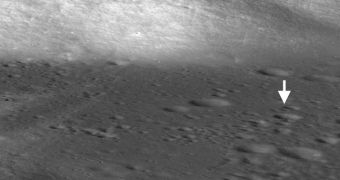Geologists and planetary scientists believe that the Moon has shrunk entirely in the past, and some evidence point that the same may be going on even now.
The data that informed the new study came from the NASA Lunar Reconnaissance Orbiter (LRO) spacecraft, which has been orbiting Earth's natural satellite since last year.
The orbiter snapped photographs depicting numerous never-before-seen cliffs in the lunar surface, which may have been produced as the shrinking process took place.
It's not that far-fetched to believe that the Moon shrunk, geologists say, if we take into account the chaotic environment in which Earth's satellite appeared.
When it was very young, it was bombarded heavily by meteorites and asteroids, which made it very hot. The wealth of radioactive elements in its insides also contributed to the elevated temperatures.
But, as time passed, the crust began cooling, and getting smaller. Now, geologists believe they may have finally connected the cooling phenomenon to the contraction of the Moon's interior.
“We estimate these cliffs, called lobate scarps, formed less than a billion years ago, and they could be as young as a hundred million years,” explains Dr Thomas Watters.
The expert is based in Washington, US, at the Smithsonian's National Air and Space Museum's Center for Earth and Planetary Studies, experts at NASA announce.
“Based on the size of the scarps, we estimate the distance between the moon's center and its surface shrank by about 300 feet [90 meters],” said Watters, who is also the lead author of the new study.
A paper detailing the finding is published in the August 20 issue of the esteemed journal Science.
“These exciting results highlight the importance of global observations for understanding global processes,” adds the LRO Deputy Project Scientist, Dr John Keller.
“As the LRO mission continues in to a new phase, with emphasis on science measurements, our ability to create inventories of lunar geologic features will be a powerful tool for understanding the history of the Moon and the solar system,” adds the expert.
Keller is based at the NASA Goddard Space Flight Center (GSFC), in Greenbelt, Maryland.
The new images were collected using the high-resolution Narrow Angle Cameras (NAC) aboard the LRO, which are especially well suited for such investigations.
Over the next few years, the NAC will be used to produce one of the most highly-detailed and accurate maps of the Moon ever made.
“The ultrahigh resolution images from the NACs are changing our view of the moon. We've not only detected many previously unknown lunar scarps; we're also seeing much greater detail on the scarps identified in the Apollo photographs,” says Dr. Mark Robinson.
He is the principal investigator of the LRO, and also a coauthor of the Science paper. The expert is based at the Arizona State University (ASU) School of Earth and Space Exploration.

 14 DAY TRIAL //
14 DAY TRIAL //